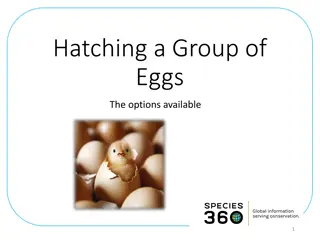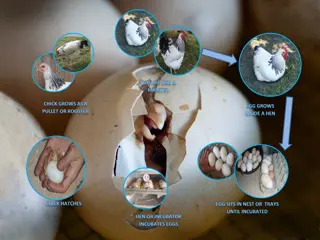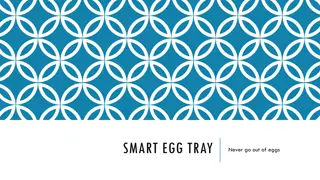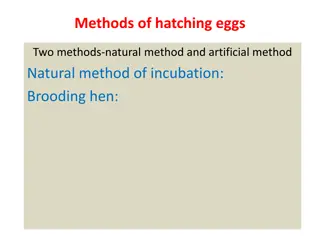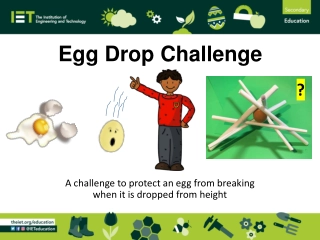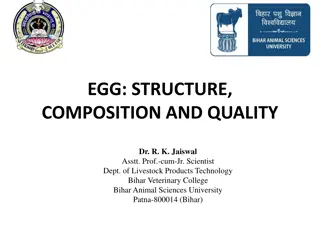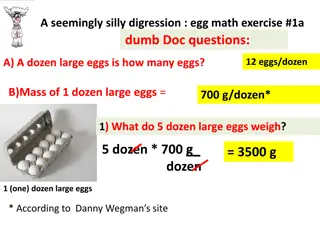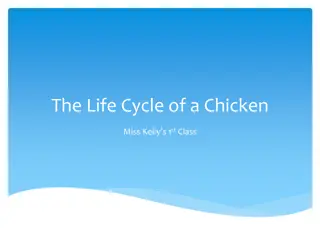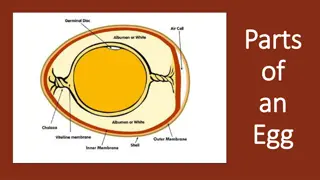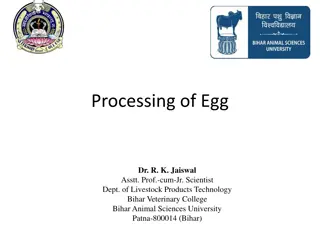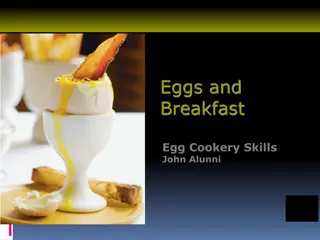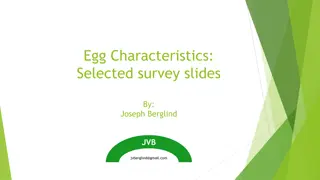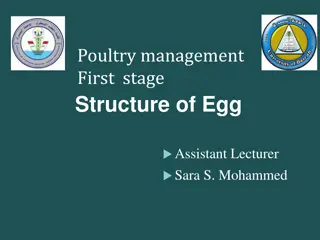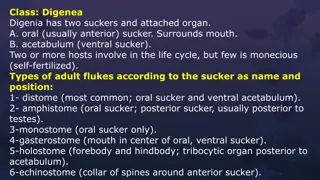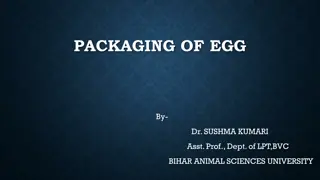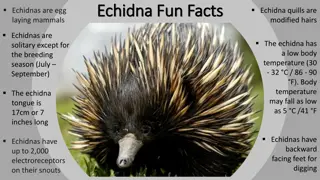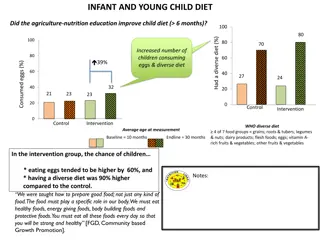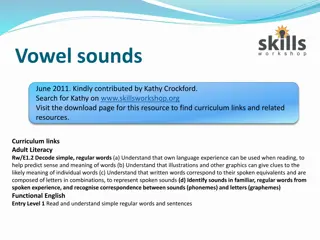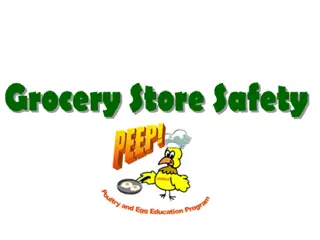Peep's Egg Hatching Adventure
Delve into the exciting journey of Peep, the little chick inside an egg, as it seeks to hatch with the help of warmth, water, and care. Explore topics such as incubation, temperature monitoring, egg development, and chick care through engaging activities and information.
Uploaded on Sep 19, 2024 | 1 Views
Download Presentation

Please find below an Image/Link to download the presentation.
The content on the website is provided AS IS for your information and personal use only. It may not be sold, licensed, or shared on other websites without obtaining consent from the author. Download presentation by click this link. If you encounter any issues during the download, it is possible that the publisher has removed the file from their server.
E N D
Presentation Transcript
Who's Hatching? ? By Alison Friend
Hi, I am Peep. I am inside this egg. I want to come out and meet you. Please help me hatch from my egg. Follow the Table of Contents to learn everything you need to know about hatching an egg. TABLE OF CONTENTS KWL Needs Incubator Temperature Comparing Temperatures Graphing Temperature How Many Days Inside an Egg Diagram Candling an Egg Sequencing Hatching an Egg Experiment Hatching Video Calendar Countdown Caring for a Baby Chick Cycle of an Egg Standards
How do you hatch an egg? Think-Pair-Share Think What do you know about how to hatch eggs? Pair Pair up with a partner. Share Share with your partner and the class. What do you know about hatching eggs? What do you want to know about hatching eggs?
What do I need? Help me hatch! Warmth Water Incubator Caretaker
How will I stay warm? An incubator is a way to keep me warm. I can stay there with all my brothers and sisters.
Is the temperature right for me? You will need a thermometer to make sure the temperature is just right for me. I like it to be between 99o-101o. Make sure warm air does not escape the incubator. Click on the thermometer and use this recording sheet to compare temperatures. thermometer animation
Comparing Temperatures Recording Sheet button
What is the temperature? Every Friday read and graph the temperature in the incubator and in the room. 120 100 80 Incubator Temp Room Temp 60 40 20 0 Day 1 Day 7 Day 14 Day 21
How many days will it take us to hatch? Predict how many days it will take us to hatch Egg Number One (ME!) Two Three Four Five Six Seven
What does my egg look like? Chalazae Yolk Albumen Egg Cell chick5 Air Sac CLICK the egg to learn more. Then click the labels for more information.
How do you candle my egg? 2002-06-28-egg-embryoHere I am! Click on me! Candling an Egg You will need: A dark room A flashlight ME! 1. Carefully take me out of the incubator. 2. Hold my egg up to the light. 3. What do you see? This is my air sac.
Can you crack an egg? Materials: opened paper clip, recording sheet, pencil, raw egg, paper plate, timer and paper towels. Directions: You will use a raw egg and the tip of an opened paper clip to find out how many pecks it takes to crack the shell and how long it takes. Make a prediction first! Have a partner keep count for you. TASK How many pecks? Prediction Actual How long did it take? Here s how I peck through my shell. What connections did you make? What do you think about my tough job?
How does a chick hatch? What do you see? Click on the egg to watch a video. eggAnimated
How many days are left? Make sure to keep a count of how many days are left until I hatch.
Are you my mother? Once I am born and dry, I will need a brooder. A brooder is a warm home for me. What else will I need? MOMMY ! A cardboard box makes a great brooder!
Can you put it in order? ? ? ? Click on me to check! ? ? chick5 ?
How did you do? 1 2 6 5 3 4
When were we born? Now that we are born your class will need to make birth announcements. We are egg-cited to announce the birth of our baby chick! Name _____________________ Birth Date ________ Time of Birth ________ Weight ________ Height ________ Proud parents in Mrs. Friend s Class!
You did it! Click here for a special treat.
Standards S.1.1.1 Inquiry: Methods/Scientific/Use The learner will be able to ask questions, make predictions, record observations, and communicate with others. S.1.1.2 Investigations: Conducting The learner will be able to engage in learning process via hands-on/minds-on science activities and experiences. S.1.5.1 Animals: Compare/Contrast The learner will be able to compare and describe different animals such as tadpoles, caterpillars, puppies, chicks, snakes, and opossums in the ways they look, grow, and move using sorting activities with pictures or models. M.1.2.1 Graphs: Create/Basic/Physical The learner will be able to construct simple graphs using concrete objects or representations of objects such as blocks, counters, or pictures. M.1.3.1 Tools: Use/Determine Measures The learner will be able to use a variety of tools to measure, standard (ruler, balance, clock, thermometer) and non-standard (cubes, pencil lengths, shoes, blocks). M.1.3.2 Length: Measure/Compare The learner will be able to compare, order, and measure length using inches or centimeters M.1.3.4 Tools: Choose/Suitable The learner will be able to select appropriate tool for determining the specified measurement of height, weight, capacity, and temperature. M.1.3.6 Time: Units/Select The learner will be able to select appropriate units (minutes, hours, days, weeks, months) and appropriate tools (clocks/watch, calendar, sun/moon) for determining a specified time. Links to websites used in this PowerPoint http://www.ikeepbookmarks.com/browse.asp?folder=1346126


